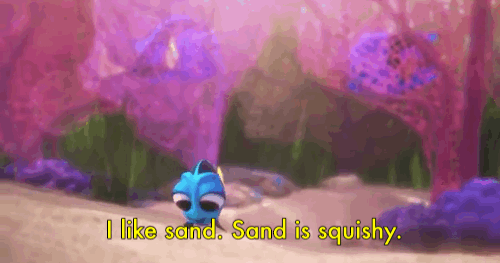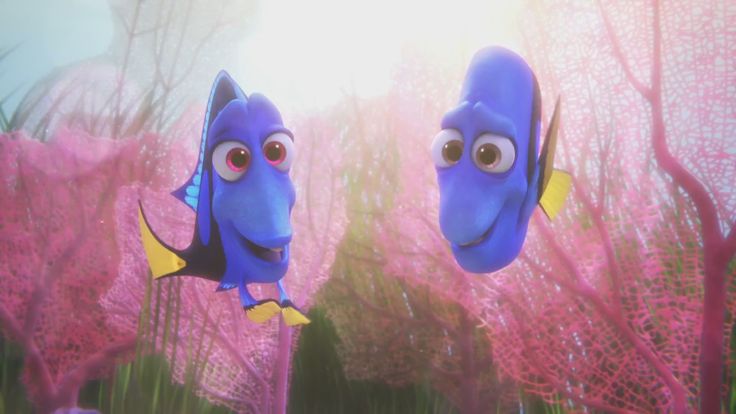Dory is the iconic name for the blue tang, (or scientifically known: palette surgeon fish) from the motion picture, Finding Nemo.
Much like its predecessor, Finding Dory personifies marine life by animating fish with character and emotions in order to get the audience to engage in a more sympathetic mindset to sea life and overall motivate a movement towards tackling oceanic pollution of the precious coral reef.
Director Andrew Stanton uses the fishes’ vulnerable memory, (a play on “memory like a goldfish”) and the characterisation of cuteness in younger Dory to create empathy towards the blue tang, closely paralleling the two, so that an audience feels a connection and sympathy for the fish, an animal that is largely overlooked.
As Dory, (Ellen DeGeneres) begins to recall her memory we are shown flashbacks to her childhood and an insight to how it all began. In this particular scene where we first see Young Dory (Sloane Murray), she appears alone on screen with all of the obvious traits of cuteness. Big violet eyes, round head and small body, which is much like Steven Gould’s essay ‘A Biological Homage to Mickey Mouse’ where, as Mickey Mouse evolves, he becomes more cute and desirable to an audience: bigger head, bigger eyes and smaller body (limbs). These factors are favoured by natural selection itself and releases dopamine and pleasure in the nucleus accumbens (University of Melbourne, 2018) part of the brain; this is also supported in ethologist Konrad Lorenz’ (1943) animal behaviour research theory of a ‘baby schema’ and the attraction of adults to infants (BBC Guides, 2018) (University of Melbourne, 2018). Stanton chose Sloane Murray to voice Young Dory with a squeaky, high pitched vocals, giggling to add to the evolutionary adaptation of cuteness. Young babies or pups will squeak or cry in a high tone which instinctively makes viewers want to help and nurture for Dory.

Some of the main plot scenes during the film are the memory and flashback scenes. These are important due to Dory’s memory loss; Stanton uses the way it appears to be shot to reassure the audience. It is important to note that as a memory the scene still seems to remain in the third person, therefore allows the reader to interpret the memory as unanimous and true to all parties involved rather than from the perspective of the already establish unreliable narrator of Dory when it comes to memory. This scene in particular shows the beautiful reflection of the water on the sand and has waves of bright aura bubbles floating across the screen, it appears almost ‘too bright’ and colourful it appears utopian with mellow music, with a faded over lay which makes it appear dream-like and immediately signals to the viewer that this is a memory or a dream. Cutting from Dory, alone, (which reinforces how isolating and touching her memory loss disability is and just how vulnerable as a character she is) to her parents together and then all three together. Often the camera angle is behind dory or the two parents to show all three characters as a family unit talking rather than a naturalistic camera angle as if it was from the eyes of a speaker Young Dory says ‘I like sand. Sand is squishy,’ and adult Dory can be heard saying the same thing, the correlations between her language are not that different as she ages allowing Dory to appear childlike and again, vulnerable; Stanton creates an emotive relationship through Dory and the audience as they readdress fishes in a new light as having complex lives and family relations.

Bibliography:
IMDb. (2018). Finding Dory (2016). [online] Available at: https://www.imdb.com/title/tt2277860/ [Accessed 16 Apr. 2018].
BBC Guides. (2018). Why are baby animals so cute?. [online] Available at: http://www.bbc.co.uk/guides/zc8bgk7 [Accessed 16 Apr. 2018].
University of Melbourne. (2018). The Science of Cuteness- How do we perceive cute? – Scientific Scribbles. [online] Available at: http://blogs.unimelb.edu.au/sciencecommunication/2013/08/26/the-science-of-cuteness/ [Accessed 16 Apr. 2018].
Coyne, J. (2018). Why are animals cute?. [online] Why Evolution Is True. Available at: https://whyevolutionistrue.wordpress.com/2010/08/11/why-are-animals-cute/ [Accessed 17 Apr. 2018].
Gould, S. (2008). A Biological Homage to Mickey Mouse. Ecotone, 4(1-2), pp.333-340.
Photograph Vincent J. Musi, N. (2018). When We See Something Cute, Why Do We Want to Squeeze It?. [online] News.nationalgeographic.com. Available at: https://news.nationalgeographic.com/2015/10/151010-science-psychology-babies-animals-culture-behavior/ [Accessed 17 Apr. 2018].
Hogenboom, M. (2018). You’ve seen Dory in Finding Nemo, now meet her in real-life. [online] Bbc.com. Available at: http://www.bbc.com/earth/story/20151111-finding-the-real-life-dory [Accessed 17 Apr. 2018].